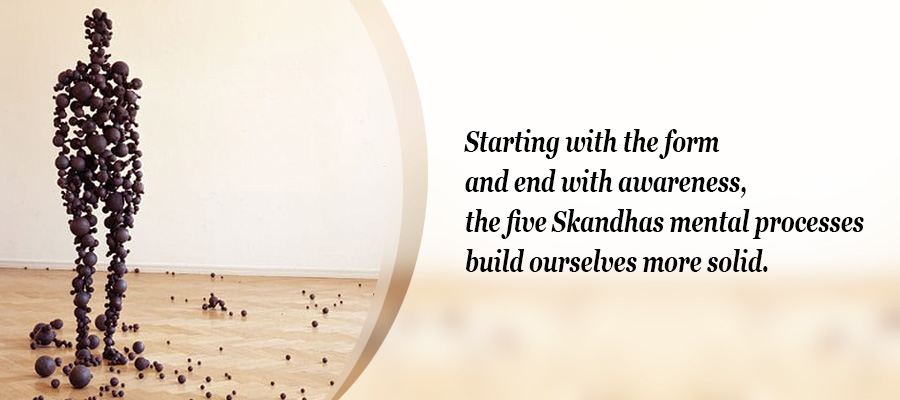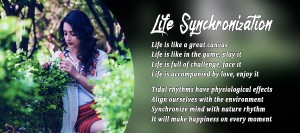We all know that we have psychological thoughts and experiences, but who are we really? How does the mind work to shape our experience of our world, the experience of feeling our life?
Psychology examines our daily experiences of clarity and confusion about our thoughts and self. Our earliest sense of self shows “5 Collections that process the development of self-ego” which is 5 Skandha, which literally means “collection” or “stack”.
Skandha is not a collection of elementary particles of existence as a momentary meeting of mental and physical events. Actually, mind and body – mental and physical – are the two main types of events. We experience ourselves as tangible beings in the world of other physical forms. We also move in the world of other living things with mental experiences.
Our 5 basic Skandhas are; (1) form, (2) feeling, (3) perception, (4) concepts, and (5) awareness. Let’s walk together through these five and examine how, step by step, they build our self-awareness.
1. The Form
The first Skandha is called “form,” which means our physical body and the body of the world. How is this part of the experience of our minds?
The form is the basis of our being, the basic feeling that we are this body, somewhat separate from this mind. This separation is the main difference in our ordinary experience.
As in a dualistic relationship, the body and mind can walk in harmony for time together, enjoying togetherness and friendship with each other. But the body and mind can also fall into deep divisions, quarrels, and rooted separations. When everything is going well, the body cooperates with what the mind seems to want, for example: “Let’s have breakfast now, okay?” But sometimes the body rebels, my knees hurt when I want to run or fall asleep during an important meeting.
The body and mind are like two siblings who are at odds but are conjoined. If we are physically tired or hungry, our experience and judgment of others may be equally spiced by fatigue or low blood sugar. A recent study shows that Israeli judges provide parole in sixty-five percent of cases heard immediately after they eat and in almost zero cases hear just before the break or at the end of the day. So the first insight into how our minds work is that understanding mental experience also requires a great deal of attention on the form scheme.
2. Feelings
The next phase in self-arising is called “feeling.” This means that our basic taste likes dislikes, or doesn’t care about anything we feel.
How do we feel about the shapes and creatures we encounter? Do they feel attractive or threatening? Do we feel like moving in or away from them? These intuitive feelings – not full emotions – are the basis for our subsequent drive towards or away from whatever we experience.
Feelings are the general background of all our experiences, changes in the texture of encounters and exchanges with our world. This does not deny that there are good and evil creatures in the world, those who pray for us well and those who will cause us harm. As they say, “Even paranoids have real enemies.”
Note that this feeling is our mental experience. Some of the pleasures of our own minds that we taste when we enjoy delicious apples. The feeling of skandha points to the main mental aspect of all our experiences. Our own thoughts accompany our experiences of anything. This sounds obvious at first, hardly worth mentioning, but it is one of the key insights of the contemplative tradition. A pleasant or unpleasant experience from anyone or anything always has an inner aspect. We call this inner aspect “mind.”
3. Perception
The next stage in self-development is called “perception.” This is a more specific affirmation than a simple and broad evaluation of feelings.
For example thumbs up (thumbs down, or neutral). “Here it is … I really like it, not only the warmth provided by my new wool sweater but also its subtle color and texture.” Perceptions about the good quality of sweaters above are all colored by biases from the past. We have considered it as having good quality based on our previous feelings.
Note that these perceptual assessments are all from the perspective of ‘I’, from the perspective of “I” which gradually strengthens.
4. Concept
The process of development of the ego becomes harder with the fourth skandha: “concept” or “mental formation.”
By concept, we now have a name for someone with a pleasant name and a bad or unpleasant name. This is an aspect of the dualistic mind which we call “false intellect”, using fixed conceptual categories to identify ourselves and others.
In this distorted field of insight, we begin cleverly deceiving ourselves based on momentary judgments, blurred intuition. For example the news yesterday: “Oh, I understand now: I am this kind of person and you are that kind of person. So we can’t be friends. Goodbye…”
At this stage, we have developed interpretations about self and experience, far beyond feelings: “I am the type of person …, because of what happened before.”
Again, this is not to deny the power of previous causes and conditions in forming beings that have become. But the temptation is to condense the water that flows from new insights into the frozen ice of fixed mental ideas.
5. Awareness
Finally, we find the fifth skandha mental experience, “consciousness.” The accumulation of momentum from the initial mind-body split, positive or negative feelings felt by others, and the label of ourselves and our world culminates in a clear display of emotions and thoughts.
This Skandha is the flow of consciousness that we know in everyday life, the flow of our thoughts. Buddhist and Hindu psychology broke it into eight separate consciousnesses. In addition to sense consciousness known to see, hear, smell, feel, and touch. Hindu and Buddhist psychology adds to the awareness of the sixth sense of “providence.”
Just as visual awareness pays attention to sight and hearing awareness is present for sound, these six thoughts are present for thoughts and emotions. It also synthesizes and integrates experiences from other consciousnesses into a coherent whole, such as film editors who are skilled at coordinating sound images, and discursive comments.
Underlying these six sense faculties, sometimes we might see two more consciousness: conflicting emotions and anxiety, winding (klesha or disturbance awareness) and even blurred background awareness (Alaya or barn consciousness) that we sometimes look back and call “me”. This underground current is a powerful instigator, sometimes overflowing with old hatred and jealousy, centralized desire, and highly motivated rejection.
We are not separate from our environment. If so, how can we breathe, eat, drink, support ourselves? Where do the languages where we speak, write and read come from?
None of us is self-produced and independent, as our mothers and fathers remind us. And far from being single, uniting beings, we emerge as a dynamic collection of physical and mental events, including breathing, sleeping, dreaming and waking up. We have emotional and physiological, skeletal and psychological aspects to our existence, and although these sometimes conflict with one another, they also work together and are in harmony.
The essence of 5 Skandhas
Insight about your own psychological process, into the way your mind works, is not an end in itself. Tradition does not offer this teaching only as intellectual knowledge or information. You are encouraged to use this map to become more familiar through direct experience, with a process you call “I” and “my mind.”
Developing harmonious friendships with oneself is a central part of the path of spiritual awakening. This teaching on the five layers of the body invites you into a deeper, more intimate experience about yourself. What do you find when you look into your own body and mind experiences?
This is not about dogma, the point is not to confirm that the map is accurate or “correct.” Part of the point is to note that maps are not the territory and can never be.
When you are involved in psychological exploration, one of your best friends is a friendly feeling toward yourself and others. Hospitality means taking these five mental processes not as a sign of inherent weakness or basic insufficiency but as your basic human aspect. Through cultivating hospitality, you can experience skandha (as well as anything that appears along the way) with real gratitude and appreciation. Let me be specific here.
The body layer of consciousness completes the development of the deceived ego-mind. We now feel separate, independent, and united – even though there is a lot of conflicting evidence.





